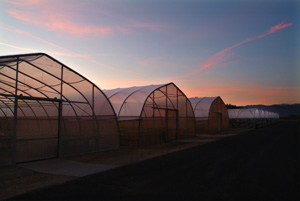8/15/2008
Freestanding vs. Gutter-Connected
Chris Beytes

Money is tight and the economy is iffy, but you need to keep producing crops—and more of them—in order to keep cash flowing in the right direction. If you need more space, should you invest in gutter-connected structures or should you think lower-cost freestanding houses?
A casual survey of a few greenhouse manufacturers reveals that some growers may be thinking the latter.
“There is definitely a trend toward lower-end structures to put up the area required to grow without investing in a high-dollar [structure],” says Bill Vietas, of Rough Brothers in Cincinnati, Ohio. “I don’t think it is a regional trend but more of a ‘market’ trend. Growers see opportunity for growth and they don’t want to pass it up.”
Scott Thompson of X.S. Smith in Washington, North Carolina, has noted the same phenomenon.
“Yes, there is a trend, no question about it,” he says. “What we’ve seen the last several building seasons is a definite trend toward lower-cost, freestanding buildings.”
Scott says many growers are looking for low-cost structures for short (four to six weeks), seasonal applications in the spring to protect crops from rain and frost. “None of the growers want to commit the funds or build out the site for the required investment because they only need that space for such a tiny window,” he says.
However, is this kind of short-term thinking good for your business? Scott says he debates that question every day.
“It’s not building the right way, [but] it is building the ‘lean’ way to get them through that period and [allow them to] invest those dollars in other items that will give them a better return. Larger-scale gutter-connected houses are certainly more efficient in the long run.”
But he adds, “We see it as a bridge or transitional period that our customers must complete in order to stay fiscally healthy and put themselves in a better position to fund that more expensive expansion when truly warranted.”
Bill Vietas says flexibility is the key, regardless. “As far as short-term and long-term thinking goes, I feel it’s important for growers to build something that’s flexible. It doesn’t hurt the master plan and it allows automation in the future.”
Jeff Warschauer from Nexus is one manufacturer who hasn’t seen this trend toward low-dollar structures—at least not among customers who’ve already seen the value of gutter-connected houses as their primary production facilities.
“To the contrary, why would someone build multiple greenhouses with all that we have to deal with relative to energy costs?” Jeff asks. “All those walls lose heat. With gutter-connected houses you have four walls, and internally you add the partition walls/zones you need.
But, he adds, “If you need space and all you can afford is a ground to ground then you have to do what you have to do. If you have funds, then build a cost-effective house in regards to space utilization and operating costs. [But] don’t get me wrong, ground-to-grounds or modified ground to grounds have a purpose and place, for sure. If you need an overwintering house or something for a short-term crop, then a freestanding ground-to-ground type house may be your best option.
In the end, there’s no one right answer. For most growers today, it’s about what they can afford today.
“Bottom-line for our customers is the bottom line,” says Scott. “Whatever they build needs to pay back immediately or it won’t fit the plan. With inflationary pressures on fuel, fertilizer, pots, packs and flats, we all have reason to worry. Yet battling through this with new products and product applications will make us stronger.”